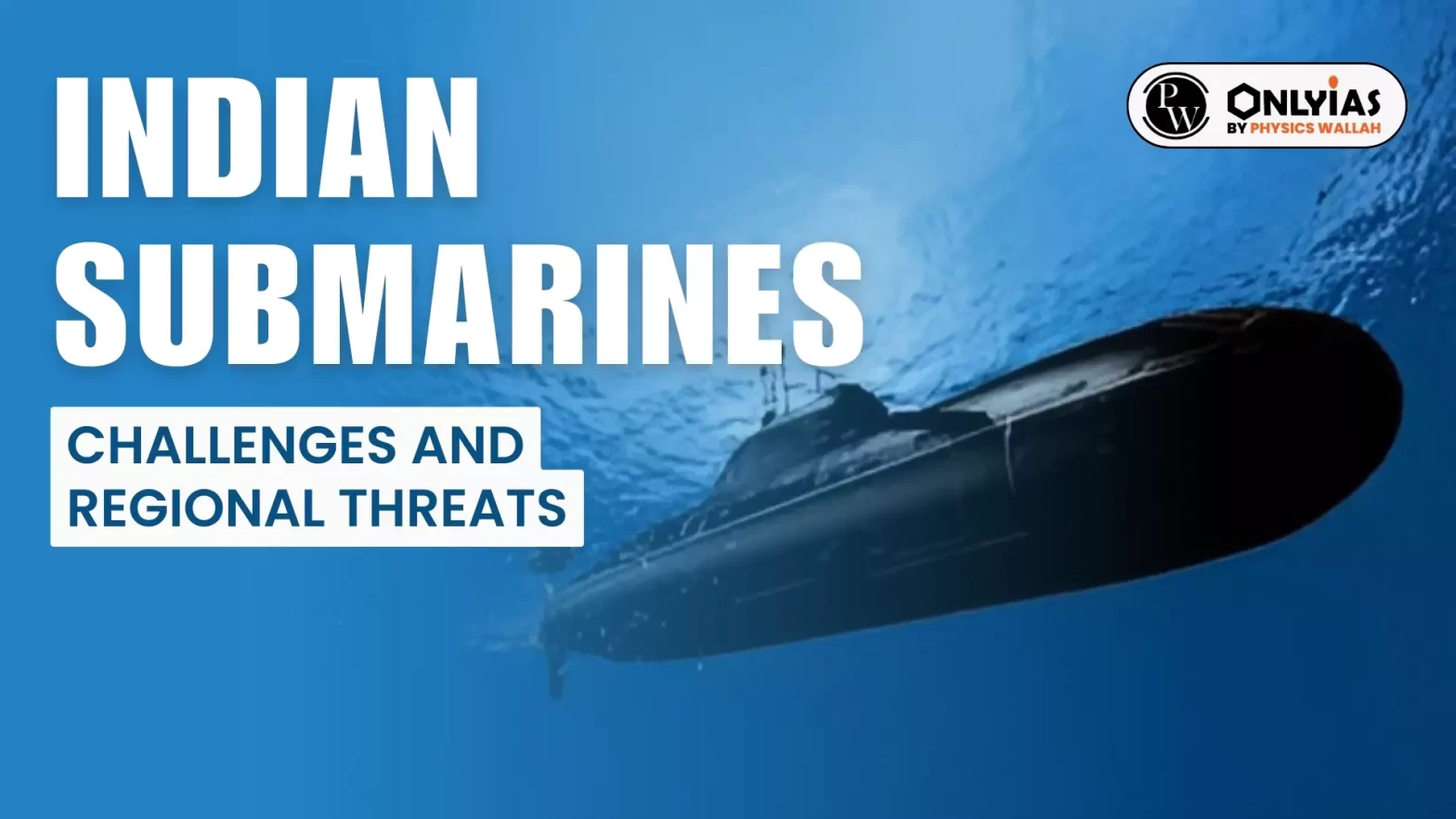Context
Recently, India has operationally deployed 11 submarines in the Indian Ocean for the first time.
Current Status of Indian Submarines
Operational Indian Submarines Fleet: India currently has 17 operational submarines: 16 conventional diesel-electric and 1 nuclear ballistic submarine (INS Arihant).
Enroll now for UPSC Online Course
- Conventional submarines include Kalvari-class (French Scorpene), Shishumar- class (German Type-209), and Sindhugosh-class (Russian Kilo) submarines.
Indian Submarine Fleet Expansion: Cabinet Committee recommended 24 submarines by 2030: 18 conventional and 6 nuclear.
Challenges with Aging Submarine Technology: Russian Kilo-class submarines from the 1980s have limited operational availability
Project 75: Project 75 launched in 2005 with France to build 6 Kalvari-class diesel-electric submarines in India, but delays persist.
Advantages of Indian Submarines
- Stealth Capability and Advanced Weaponry: Stealth capability and advanced weapons like torpedo missiles and nuclear warheads
- Advanced Capabilities: Strategic deterrence capability, countering enemy attacks
- Enhancing India’s Position in Regional Security Dynamics: India operationalized its nuclear triad with the deployment of INS Arihant in 2018, strengthening its second-strike capabilities.
- Role of Submarines in World wars: Submarines played crucial roles in World Wars 1 and 2.
- Other advantages: securing sea lanes, surveillance, intelligence gathering, and research purposes.
India faces Two Issues in Indigenous Submarine Development
Lack of capability in submarine design, which takes 5-7 years Indian industry’s inability to supply, and critical equipment, leading to dependence on foreign companies.
Challenges to the Indian Submarines
- Navigating India’s Submarine Supply Challenges: India faces challenges with submarine supply delays and maintenance issues.
- Post-Kargil War Assessment: After the 1999 Kargil War, the Cabinet Committee stated that 24 submarines are essential for India’s security.
- Insufficiency and Growing Threats: 11 submarines are still insufficient considering China’s increasing presence in the Indian Ocean.
- Vulnerabilities of Diesel-Electric Submarines: Diesel-electric submarines need to surface every 48 hours for battery recharge, making them vulnerable.
- Shift Towards Air Independent Propulsion (AIP) Systems: Countries are focusing on Air Independent Propulsion (AIP) technology submarines that can stay underwater for 2 weeks
- Advantages of AI Submarines: AI submarines offer advantages over nuclear submarines, such as swift attacks and advanced stealth capabilities.
- Talks between India and German for AIP submarines are in the final stage
- Setbacks in Project 75: India is working on Project 75 for AIP submarines, but France and Russia have withdrawn due to India’s requirements and terms & conditions.
Challenges to the Indian Nuclear Submarines
- India’s Lack of SSN Submarines: India currently has no SSN submarines, which can stay underwater for extended periods, only surfacing for food supply.
- Challenges with Leased SSN Submarine: India leased an AKULA-class SSN submarine from Russia but decommissioned it in 2021 due to issues.
- India’s SSBN Capability: India has one SSBN-class submarine, INS Arihant, with K-15 missiles (750-1500 km range) and plans to deploy K-4 missiles (3500 km range).
Pakistan’s Growing Submarine Strength
- Pakistan’s Submarine Expansion: Pakistan’s navy is becoming stronger with submarines
- Existing Submarine Fleet:Pakistan currently has 8 submarines, and China is providing 8 more advanced submarines
- Advancements in Submarine Technology: Pakistan will be the only South Asian country with Air Independent Propulsion (AIP) technology submarines, which India currently lacks
- Maintaining Regional Influence: India needs to execute its submarine plan in a timely manner to maintain its sphere of influence in the Indian Ocean.
China’s Submarine Capabilities and India’s Advantage
- China’s Submarine Fleet Overview: China has 56 submarines, including 12 nuclear submarines (6 SSN-class)
- Chinese Submarine Activities in the Indian Ocean: Chinese submarines have been detected in the Indian Ocean, and China sends spy ships for mapping the ocean bed
- India’s advantage: Chinese submarines must pass through the shallow Malacca Strait, making them surface and detectable by India’s Andaman Nicobar base
- Ensuring Naval Supremacy: India needs to match its nuclear submarine capabilities with China to maintain supremacy in the Indian Ocean
- India-France Nuclear Submarine Negotiations:India is in talks with France for nuclear-powered attack submarines.
Enroll now for UPSC Online Classes
Conclusion
As India navigates budgetary limitations and geopolitical complexities, sustained investments and long-term vision are essential to realizing its ambitions for a formidable naval fleet capable of safeguarding its maritime interests in the Indian Ocean region and beyond.
Also Read: BrahMos Missiles Range Extended For The Indian Navy
| Prelims PYQ (2016):
Which one of the following is the best description of ‘INS Astradharini’, that was in the news recently?
(a) Amphibious warfare ship
(b) Nuclear-powered submarine
(c) Torpedo launch and recovery vessel
(d) Nuclear-powered aircraft carrier
Ans: (c) |
![]() 20 Apr 2024
20 Apr 2024

